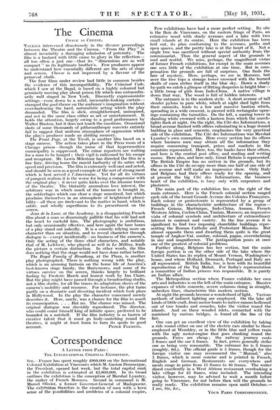Correspondence
A LETTER FROM PARIS : THE INTERNATIONAL COLONIAL EXHIBITION.
Sin,—France has spent roughly £900,000 on the International Colonial Exhibition at Vincennes which M. Gaston Doumergue, the President, opened last week, but the total capital sunk in the exhibition is estimated at £2,600,000. In its broad outlines the exhibition is the conception of Marshal Lyautey, the maker of French Morocco. Second in command is M. Marcel Olivier. a former Governor-General of Madagascar. The exhitnttbn therefore is the creation of men with a keen sense of the pz.zsibllities and problems of a colonial empire.
Few exhibitions have had a more perfect setting. Its site is the Bois de Vincennes, on the eastern fringe of Paris, an extensive wood with shady avenues and a lake with two small islands at its centre. Here the exhibition has been laid out, its plan conforming to the avenues, paths and. open spaces, and the pretty lake is at the heart of it. Not a single tree was sacrificed without special authority from the commissariat. Thus the general aspect of the grounds is cool and restful. We miss, perhaps, the magnificent vistas of former French exhibitions, for except in the main avenues one sees little of the exhibition at one time., But in com-, pensation the grounds are full of surprises. One finds the, lure of mystery. liere, perhaps, we are in Morocco, but over the tree tops a strange tower crowned with the horned skulls of oxen etches itself in the blue sky. Down a shady- by-path we catch a glimpse of flitting draperies in bright blue— a little troop of girls from Indo-China. A native village is down that way. The wood is full of hidden interests. The entrance is in the modern style. A short avenue of tall slender pylons in pure white, which at night shed light from their summits, leads to a low and massive bastion which, spreading in a wide crescent, is pierced with rectangular open-' ings containing the turnstiles. On the left, a soaring tower in dazzling white crowned with a lantern from which the search- lights flash at night. On the right, the Cite des Informations a broad avenue flanked with offices culminating in a huge domed building in glass and concrete, emphasizes the very practical side of the exhibition. The Cite des Informations was Marshal Lyautey's own conception. Here every section has its offices where business men may obtain all the information they require concerning transport, prices and markets in the countries represented. Here, too, the banks have their offices, and here is the central post office, and reading and writing rooms. Here also, and here only, Great Britain is represented. The British Empire has no section in the grounds, but its offices in the Cite do occupy more than one half of one side of the avenue and will make an impressive show. Only Italy and Belgium had their offices ready for the opening, and at present the big Cite des Informations, the business heart of the exhibition, is busy only with carpenters and plasterers.
The main part of the exhibition lies on the right of the main entrance. Here is the French colonial section ranged each side of the broad Grande Avenue des Colonies Fransaises. Each colony or protectorate is represented by a group of buildings in the characteristic arohitecture of the region— French Guiana, Martinique, Indo-China, Annam, French Western Africa, Cochin-China, Tunisia, Morocco, an impressive Nista of colonial symbols and architecture of extraordinary interest in contrast and variety. In the fine avenue it is significant to find two imposing churchlike buildings repre- senting the Roman Catholic and Protestant Missions. But almost opposite them and dwarfing them quite is the great temple of Angkor-Vat, sombre, colossal, pagan, overwhelming in size and magnificence. The juxtaposition poses at once one of the greatest of colonial problems.
Further along, Belgium has her section, but the main foreign portion is on the other side of the lake where the United States has its replica of Mount Vernon, Washington's house, and where Holland, Denmark, Portugal and Italy are all represented. British India, too, is here with its beautiful reproduction of. the Taj Mahal. For India's representation a committee of Indian princes was responsible. It is purely an Indian affair.
The Metropolitan section where France exhibits her own arts and industries is on the left of the main entrance. Massive expanses of white concrete, severe columns rising in straight, unbroken lines, characterize this modern section.
At night the grounds become a wonderland of light. Various methods of indirect lighting are employed. On the lake all kinds of little craft, from motor-boats to native canoes hollowed out of tree trunks and coracles, take the visitor round the islands. And on these wooded islets, connected with the mainland by curious bridges, is found all the fun of the fair...
One can get an excellent view of the exhibition by taking a ride round either on one of the electric cars similar to those employed at Wembley, or in the little blue and yellow train with the ugly motor-engine that goes clanking round the grounds. Fares are cheap ; the railway journey costs 5 francs and the car 3 francs. In fact, prices generally strike one as being very reasonable. The entrance fee is 3 francs (roughly, 6d.). The official guide is 5 francs, though for the foreign visitor one may recommend the " Manual," also 5 francs, which is more concise and is printed in French, English and German. Restaurants are everywhere and meals range in price from 15 francs to 40 francs. The writer dined excellently in a West African restaurant overlooking a lake village for 25 francs, wine included. The intending visitor, however, may be advised to wait a month before going to Vincennes, for not before then will the grounds be really ready. The exhibition remains open until October.— I am, Sir, &c.,
YOUR PARIS CORRESPONDENT.


















































 Previous page
Previous page